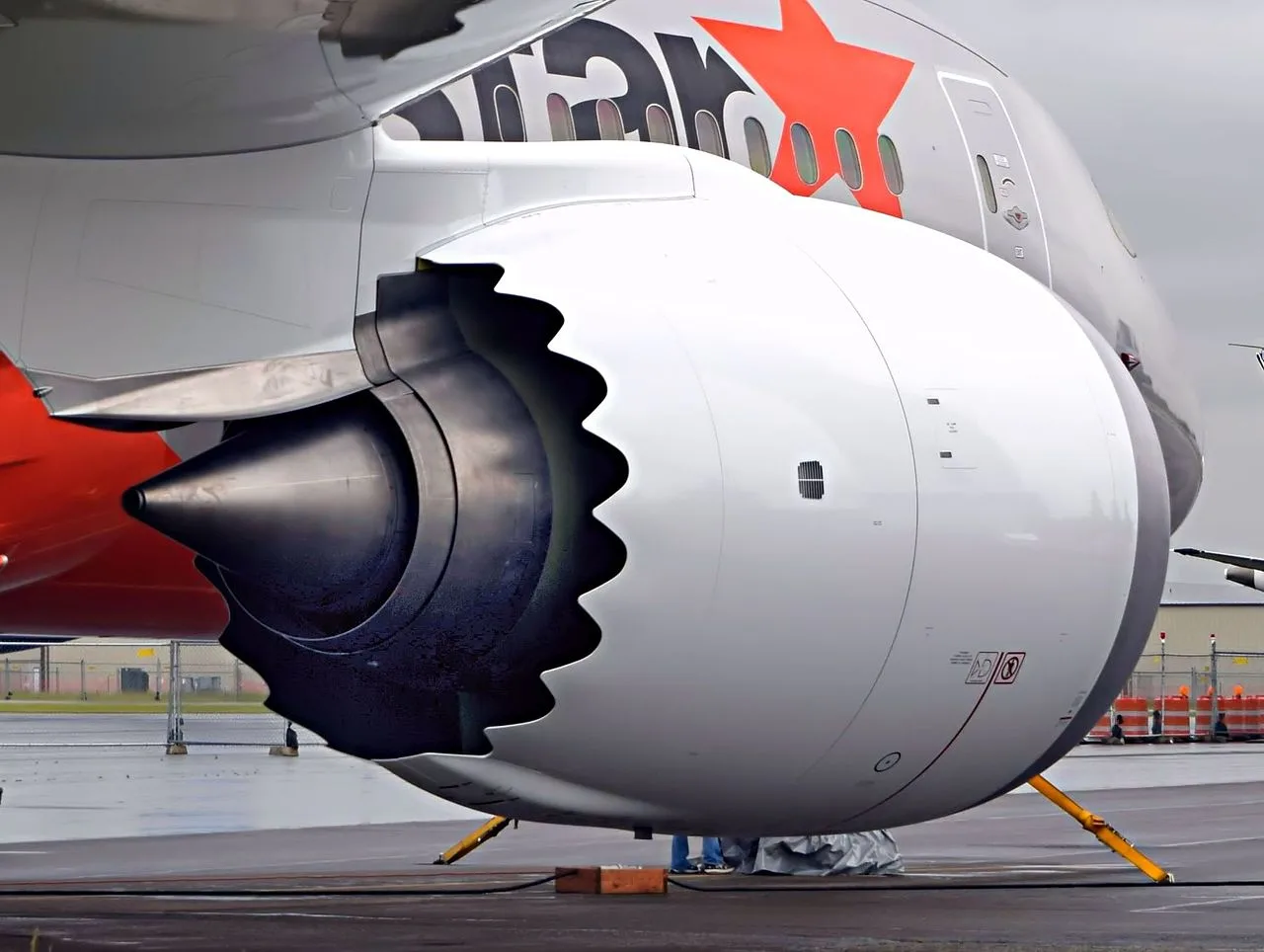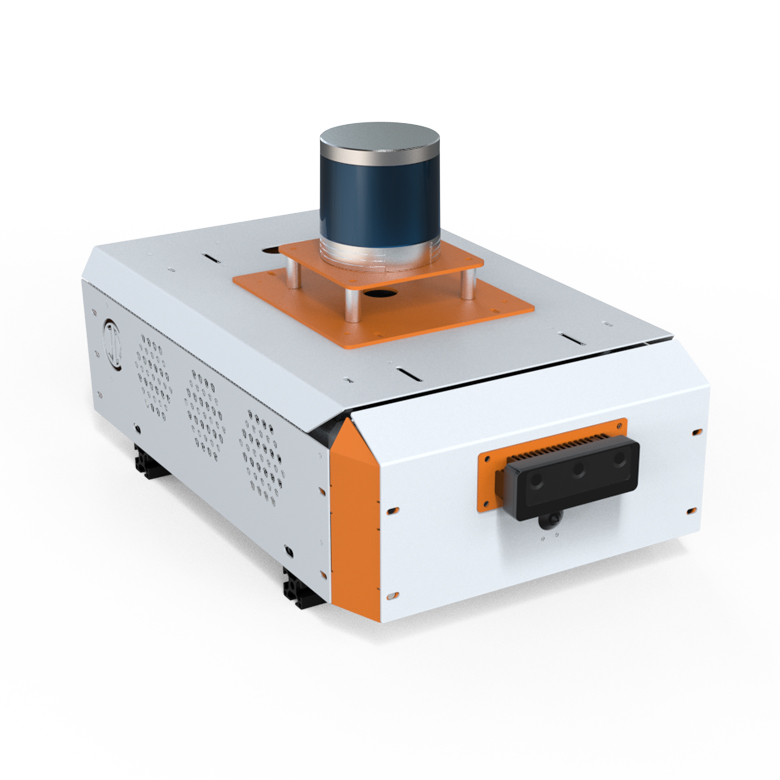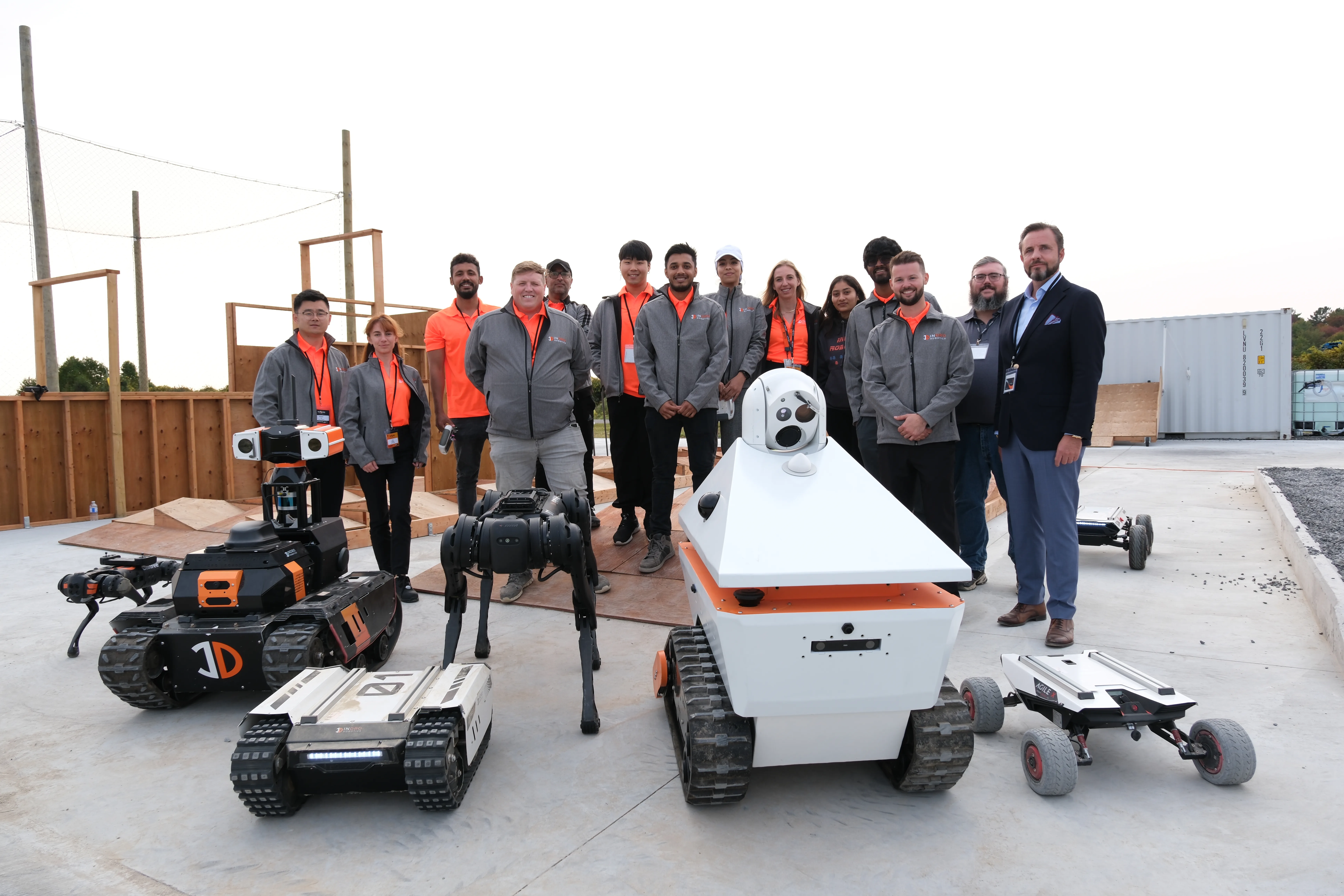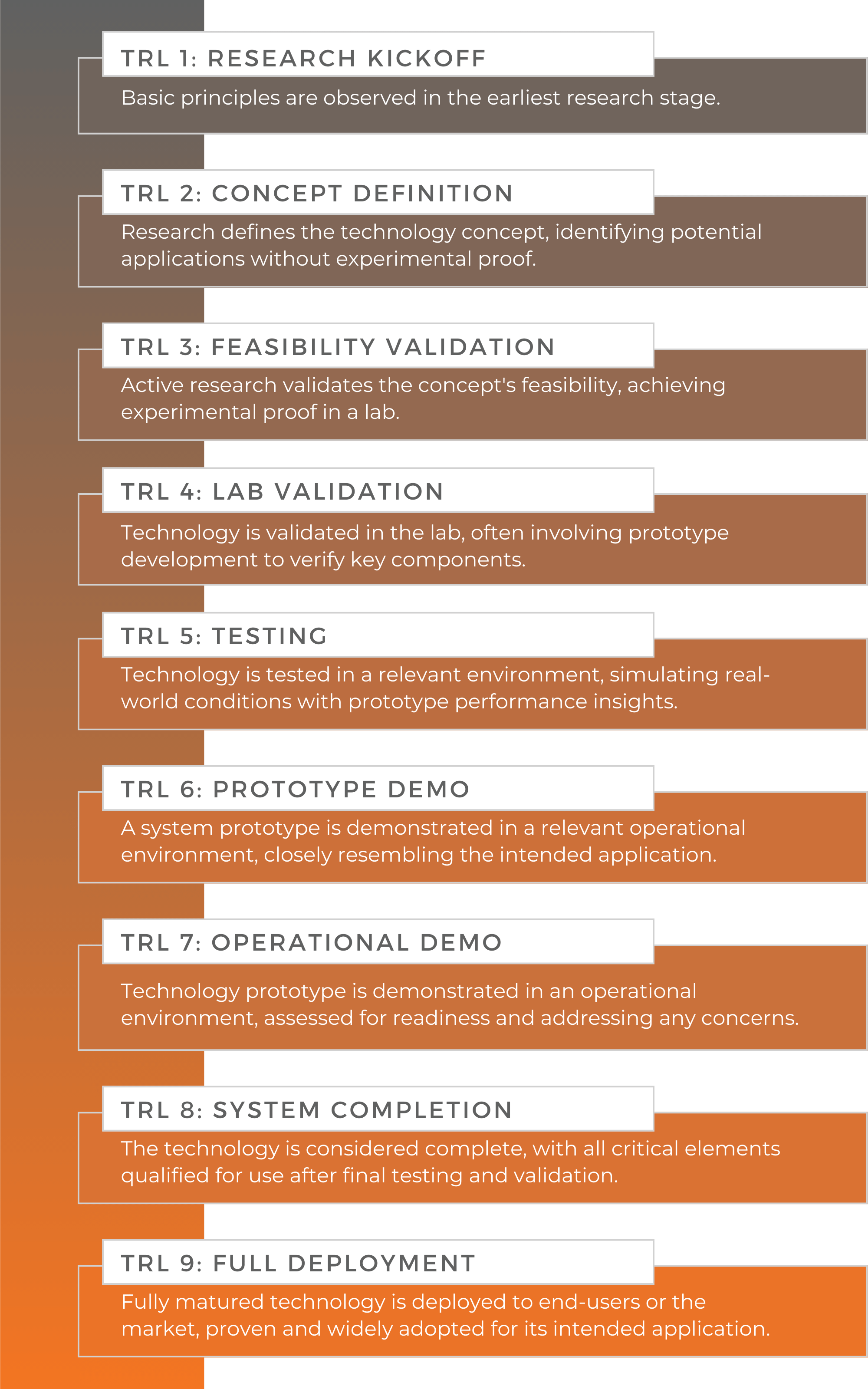By Scott Simmie
So: You’ve got a great idea for a new technology product or process.
That’s the first step: A concept that you’ve put some thought into. Of course, there’s a long road ahead before that brilliant idea becomes an actual commercial product. But how do you gauge that progress as you move along the development path? How would you describe where you’re at in a way that others might quickly grasp?
Luckily, there’s a tool for that. It’s called the Technology Readiness Levels scale, or TRL.
“It’s a standard measuring stick for everyone to communicate where they are with development,” explains InDro Robotics Engineering Lead Arron Griffiths.
The TRL tool was first developed by NASA researcher Stan Sadin back in 1974 with seven basic levels. It would take another 15 years before the levels were formally defined, during which time two additional levels were added. There are now nine steps up the ladder, where TRL 9 is the equivalent of a working product that could be mass-produced or commercialized.
Which means, of course, that Level 1 is at the very beginning of the technology development process.
“Level 1 is universally seen as a napkin idea – where you’ve jotted down a concept,” says Griffiths.
That’s a perfect analogy for TRL 1.
For greater clarity, each level on the scale offers a short definition, a description, and examples of activities. The short definition for Level 1 is “Basic Principles Observed and Reported.” The description is “Lowest level of technology readiness. Scientific research begins to be translated into applied research and development (R&D).”
In terms of examples, Level 1 “Activities might include theoretical studies of a technology’s basic properties.” And yes, that could include a napkin sketch.
Below: Aerospace is one of many industries to use TRLs. The noise-reducing chevron nozzles seen on the cowling below would have gone through each of the nine levels. Photo via Wikimedia Commons by John Crowley.

MOVING UP THE SCALE
Great! You’ve got that napkin sketch done.
Obviously there’s a lot to do between that initial idea and a finished product suitable for commercialization. To get to TRL 2, you simply need to put more thought into it. You’re not actually building or programming yet, just putting greater clarity and focus on what you hope to accomplish.
TRL 2 is defined as “Technology concept and/or application formulated.” Here’s its description:
“Invention begins. Once basic principles are observed, practical applications can be invented. Applications are speculative, and there may be no proof or detailed analysis to support the assumptions.”
You could think of this stage as refining the idea, with activities limited to research and/or analytical studies.
TRL 3 means you’re actually beginning the R&D process. This might include some lab or analytical studies. At this stage you’re trying to validate predictions you’ve made about separate elements or components of the technology. The components you’re working with aren’t yet integrated – nor is it expected that the components you’re working with are at their final version.
TWO TRL SCALES
Before we move along, it’s worth noting there are actually two different TRL scales in use. The first (and the one we’re using here) is the NASA scale. But the European Union has its own TRL scale.
“So there is some cloudiness,” explains Griffiths. “Typically the top and bottom of the scales are the same, but the middle moves around a bit. You have to be sure people are reading from the same scale. Typically when I talk to a client, I will show them the scale I am using.”
Griffiths also emphasizes that during R&D, the phase of development doesn’t always slot neatly into one of the TRL stages.
“It’s typical to say: ‘We’re roughly about TRL 6’ – it’s not an exact science.”
Below: The InDro Commander module, with LiDAR sensor. This popular commercial product, which allows for rapid integration of ROS-based robots and sensors (and more), is TRL 9.

CLIMBING THE LADDER
American inventor Thomas Edison once said: “Genius is one per cent inspiration and ninety-nine per cent perspiration.” The same could be said of the process of inventing a product for commercialization. Once that napkin sketch is done (the one per cent), there’s still a lot of methodical slogging ahead. (Trust us, we know.)
TRL 4 is the stage where you’re putting things together. Basic components are integrated and readied for testing in a simulated environment. The short definition, via Canada’s Department of National Defence, is “Component(s)/subsystem(s) and/or process validation in a laboratory environment.”
The logical progression continues with the next step.
“TRL 5 means it’s ready for testing in a lab environment,” explains InDro Lead Engineer Griffiths. He also adds that this middle stage – TRL 4 through 7 – “is always the difficult part.”
Once TRL 5 is passed, it’s time to start seeing if the integrated components will work together in a simulated or lab environment. At this stage, TRL 6, the product is considered to be getting pretty close to its desired configuration. Yes, there will be further tweaking to come, but you’re getting there.
Below: InDro’s Street Smart Robot (the large white unit). The product has been built but not yet deployed in winter conditions. This would be at TRL 7. Every other robot in this image would have made it to TRL 9.

NEARLY THERE!
All that hard work has been paying off. Your product is assembled and has been tested in simulation or other lab environment. Now it’s time to get it out into the real world to see how it performs. Congratulations, you’ve reached TRL 7, where “Prototype system [is] ready (form, fit, and function) for demonstration in an appropriate operational environment.”
“TRL 7 is more like a long-term deployment. Once you can show it to be working in a real-world environment – outside of the lab – then you get to Levels 8 and 9,” says Griffiths.
These final two levels are usually pretty exciting. Once the product/solution has been proven to work in its final form – and in the environment where it’s expected to be deployed as a product – you’ve reached TRL 8. Just one more to go.
THE FINAL LEVEL
Remember that Street Smart Robot you just saw a picture of? Well, it’s ready to go. And once the wintry conditions take hold in Ottawa, we’ll be operating that machine in ice and snow on Ottawa streets. Specifically, on bike lanes in Ottawa, where it will detect hazardous conditions (including potholes) that might pose challenges for safe cycling. City of Ottawa maintenance crews will then be notified of the problem (and its location) so they can address the issue. (You can read more about the SSR here.)
And once the SSR is operating smoothly in those intended conditions? We will have achieved TRL 9, meaning “Actual solution proven through successful deployment in an operational setting.”
NOT ALWAYS A SMOOTH PATH
It’s easy enough to describe these levels. And in doing so, it can appear to be a straightforward, linear path where engineers move seamlessly from one level to the next. Reality is not quite so simple. Depending on the project, progress in the early stages can be made very rapidly.
“Most people get up to Level 5 fairly quickly,” says Griffiths. “You can even get to Level 5 in a day if you’re doing software development – you can literally go from an idea all the way up to a basic rudimentary prototype.”
But – as flagged earlier – things get a little trickier once you hit those middle levels.
“You can think of it as walking up a hill to Level 5,” he says. “Then there’s this valley. A lot of stuff dies in Level 6 and 7. There’s not a lot of success there because once you push the technology into actual environments the success rate is very low. So a lot of time is spent in Levels 5 and 6 trying to make a system that can make it to Level 7 successfully, and then on to Level 8 – where you’re essentially across the valley.”
Below: A graphic outlines the short definitions of Technology Readiness Levels

INDRO’S TAKE
The TRL scale is extremely useful in the R&D world, in that it concisely conveys where a product is along the path to commercial development. And while it’s great for engineers, it’s also useful to help clients understand where one of our products is along that journey.
We’ve scaled this ladder many times over the years. Sometimes it’s a relatively easy climb. But, like all Research and Development companies, we’ve also had a few products that never made it beyond the valley Arron Griffiths described. That’s R&D.
“The Technology Readiness Level scale is a really useful tool, and part of our daily language at InDro Robotics,” says CEO Philip Reece. “Each level represents unique challenges – and that valley Arron described can sometimes be a disappointing bit of landscape. But we learn something even with the occasional failure.
“Thankfully, we have a creative and tenacious engineering team that seems to thrive on difficult challenges – and InDro now has a growing stable of products that have achieved TRL 9 and gone on to commercial success.”
If you’re working on your own project and would like to know where it is on the TRL scale, you can use this assessment tool from Industry, Science and Economic Development Canada.

